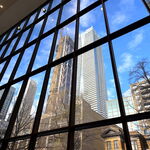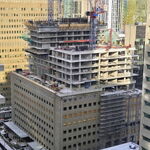Frank Gehry talks about his AGO redesign
http://www.thestar.com/entertainment/article/535213
Nov 12, 2008 04:30 AM
MARTIN KNELMAN
For Frank Gehry – the man who reinvented the Art Gallery of Ontario – what matters most about this week's grand reopening is feeling the late Ken Thomson would have approved.
"It sounds terribly romantic," the 79-year-old architect said yesterday in an exclusive phone interview with the Star, "but I had a strong feeling as David (Ken's son) and I were working on installing his collection, we could feel Ken's presence."
It is a deep regret for Gehry that Thomson, who died in 2006, will not be there for the opening. And now, owing to a family medical emergency, Gehry worried he might have to cancel plans to fly here today by private plane for tonight's black-tie thank you dinner in the AGO's Baillie Court and tomorrow's media conference.
How the AGO project developed, Gehry revealed, is different from what he was orginally asked to do: design a new building near the south end of Grange Park to house the Thomson collection.
If Gehry does make it to the opening, he will surely receive a hero's welcome. And what he is most proud of is how the art looks.
"There are these fashion trends widely emulated in the gallery world," Gehry says.
"If you love art, you have to pay attention to how you show it. Putting things on a pedestal hurts the art and I didn't want to do that. It's a miracle, but the galleries for Ken's Canadian collection are the best I've ever done. Even with white cubic spaces we managed to give them soul."
It's clear from the emotion in Gehry's voice that what matters to him more than the opinion of the world, the critics, the Toronto public or even the AGO brass is feeling he has done right by the late benefactor, who triggered this project by donating his art collection and $70 million.
These two aged titans had little in common, on the face of it, except both had once lived in Timmins, both were hockey fans and both became dominant figures in a league of their own.
Thomson grew up the privileged son of a ruling press baron, Roy Thomson, and found through collecting art a way to establish his own identity.
The future architect grew up Jewish (as Frank Goldberg) in a community of struggling immigrants.
But it was the bond between these two that enabled the project to overcome a daunting series of obstacles.
Regrets? He has a few (as the song goes).
Chief among them: "Barton Myers used to be a friend of mine. That weighs heavily on me."
Myers, who moved to L.A. 20 years ago, is the noted architect who designed the AGO's 1992 renovation. And Myers takes a dim view of what he calls "the destruction" of his building.
"It was not my intention to mess with Barton's building," says Gehry, explaining that he was originally asked to design an addition to the AGO that would have been built on land occupied by the Ontario College of Art & Design. "It was all a matter of budget constraint," says Gehry. "The AGO would have needed an additional $100 million they didn't think they could get. I asked Matthew Teitelbaum (CEO of the gallery) to call Barton and explain that taking down his building was not my idea."
The upshot: "We did the best thing we could do on our budget; a very complicated way of interweaving things within a structure that had been remade many times. There are a few details I'd like to modify and maybe some parts aren't exactly right, but on the whole I think it works surprisingly well. I'm still hoping I can get up there at some point this week. And I like to think Ken would be proud of what we've done."
mknelman@thestar.ca





